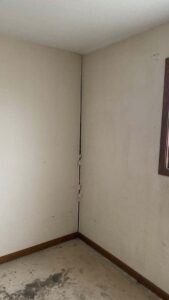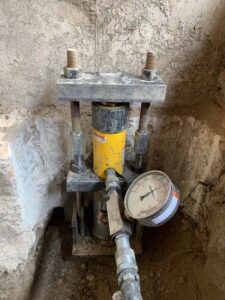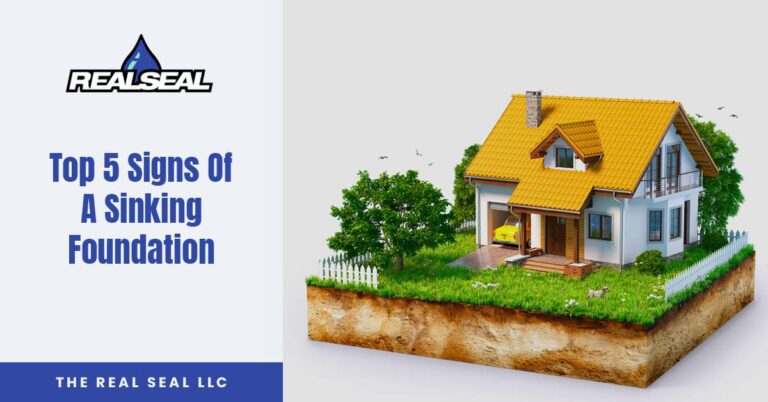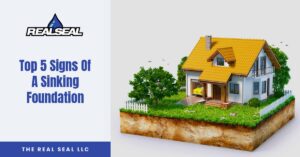If you want to know how to spot signs of a sinking foundation, this is the article for you. Whether you are looking to buy, build, or currently own a home, spotting a sinking foundation can save you thousands of dollars in major repair costs. After this blog, you’ll have all the information you need to pick up the phone and save your foundation before the settlement worsens.
What Causes A Sinking Foundation?
Excess groundwater, voids, and unstable soil can all lead to a sinking foundation. Most homes will experience initial uniform settlement within seven years of being built. After seven years and without any exterior forces, the home will not typically move for over 250 years.
This is because the concrete has a chance to adjust itself into the soil once it experiences different temperature and humidity levels.
If the settlement is uniform across your entire foundation within fractions of an inch, it’s perfectly normal. If the settlement/sinking is uneven, meaning one side of your home has sunk deeper than another side, your foundation and home are structurally compromised. This form of settlement is called differential, and if left untreated, each problem it causes can worsen over time.
Here are some of the major causes of differential settlement and sinking foundations.

- Poor drainage – If your property is sloped toward your home, water could erode the soil underneath your foundation, creating pockets that allow settlement.
- Poor soil quality – If the soil below your foundation contains too much clay, it can expand and shrink based on moisture content. When the clay absorbs water, it swells and lifts your foundation. Then, when the soil dries, your foundation will sink as the dirt shrinks.
- Poor compaction – Before your foundation was poured, builders compacted the soil together to eliminate any voids or pockets. If builders fail to compact the soil, your foundation will settle into the pockets left behind.
- Tree roots – Invasive tree roots can stretch below your foundation and absorb the moisture inside the soil, shrinking it. Then, when the tree roots die, the pockets left behind can cause settlement.
- Soil creep (downhill creep) – If your home was built on a hill or at the bottom of a hill, mudslides and heavy rains could shift the soil below your foundation, sinking or damaging it.
- Natural disasters – Earthquakes, floods, and extreme drought can all cause your foundation to shift or settle.
- Poor construction and renovations – If your foundation or home was improperly built, a lack of stability can cause it to settle. If you plan to add another floor to your home without checking if your foundation can handle the additional weight, it could lead to a sinking foundation.
Top 5 Signs Of A Sinking Foundation
Here are the top five most common signs you have a sinking foundation.

- Sticking windows and doors – When sections of your foundation settle, your window and door frames will shift out of place, causing your doors and windows to stick when you open or close them.
- Uneven, cracked, or sloped floors – A sinking foundation can warp, crack, and slope your wooden, concrete, vinyl, or tile flooring. This leads to leaning appliances, tilting furniture, and trip hazards. Pay attention to any floor cracks that run from one wall to another since these are major signs of a sinking foundation.
- Sections of your home are separating – A sinking foundation can cause your walls, floors, and ceiling to separate, leaving gaps in your moldings or baseboards. This also applies to homes with porches and chimneys since a sinking foundation can cause these to separate from the rest of your home.
- Cracks on your foundation, fascia, and drywall – Cracks on your foundation walls wider than 1/10th of an inch clearly indicate that your foundation is sinking or shifting. Pay attention to any stair-step cracks on your concrete block foundation walls, exterior brick fascia, and diagonal cracks near your doors and windows. Some foundation cracks might result from age or mild concrete shrinkage, but these should still be repaired because they allow water seepage.
- Bowing walls – A sinking foundation can exert pressure on your basement walls and cause them to bow inward.
How To Lift And Level A Sinking Foundation

Experts can lift and level your sinking foundation using underpinning, a repair solution that dates back to the 50s in Italy. Underpinning uses long steel piers that are either pushed or drilled into the soil below your foundation, searching for load-bearing strata (underlying soil or rock that can bear the weight of your home).
Both pier systems are anchored to your foundation footers and use hydraulic jacks to push down onto the piers, lifting your foundation back to the maximum practical level. There are two types of underpinning methods: push piers, which are pushed into the soil, and helical piers, which are drilled into the soil.
Do You Have A Sinking Foundation?
If you notice any signs of a sinking foundation that we mentioned above, call The Real Seal. We’ve been repairing sinking foundations throughout Chicagoland since 2011, skilled in the most modern and advanced techniques. We also offer foundation waterproofing, crawl space encapsulation, concrete lifting, and more. Call today for your free inspection.







2 Responses
Do you work in NY Long Island?
Bayville?
Hi Grace! Unfortunately we do not. We are located in Chicagoland.